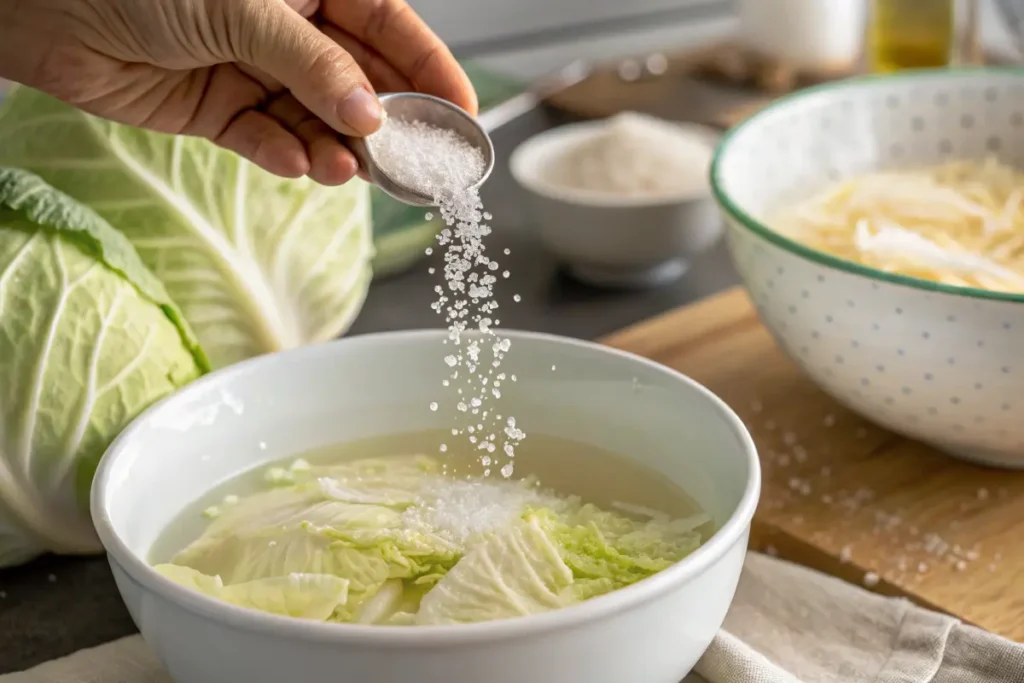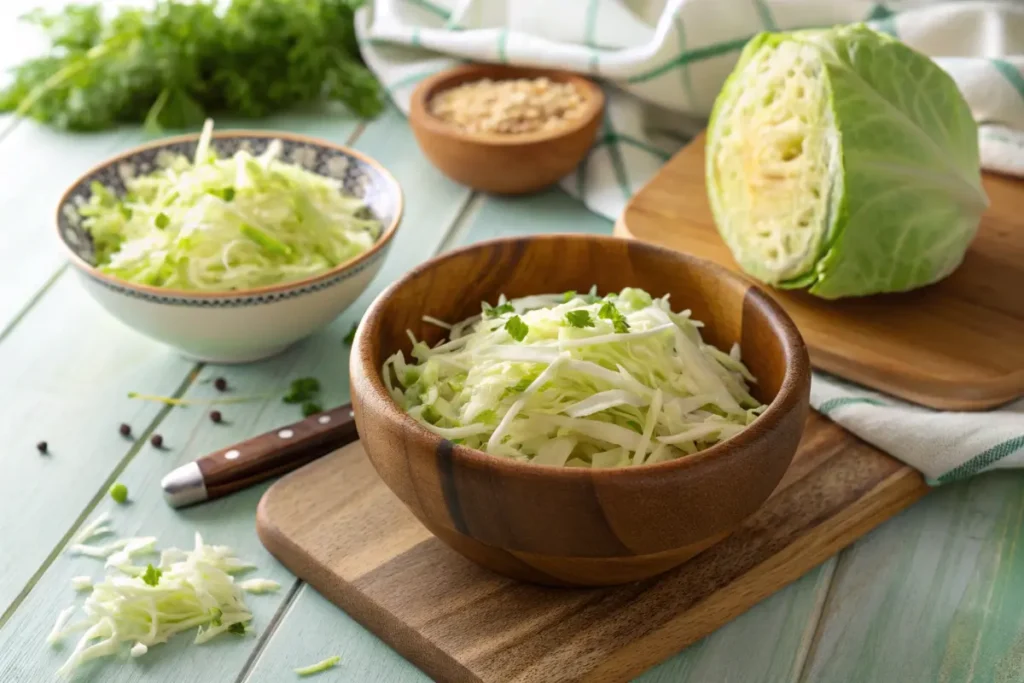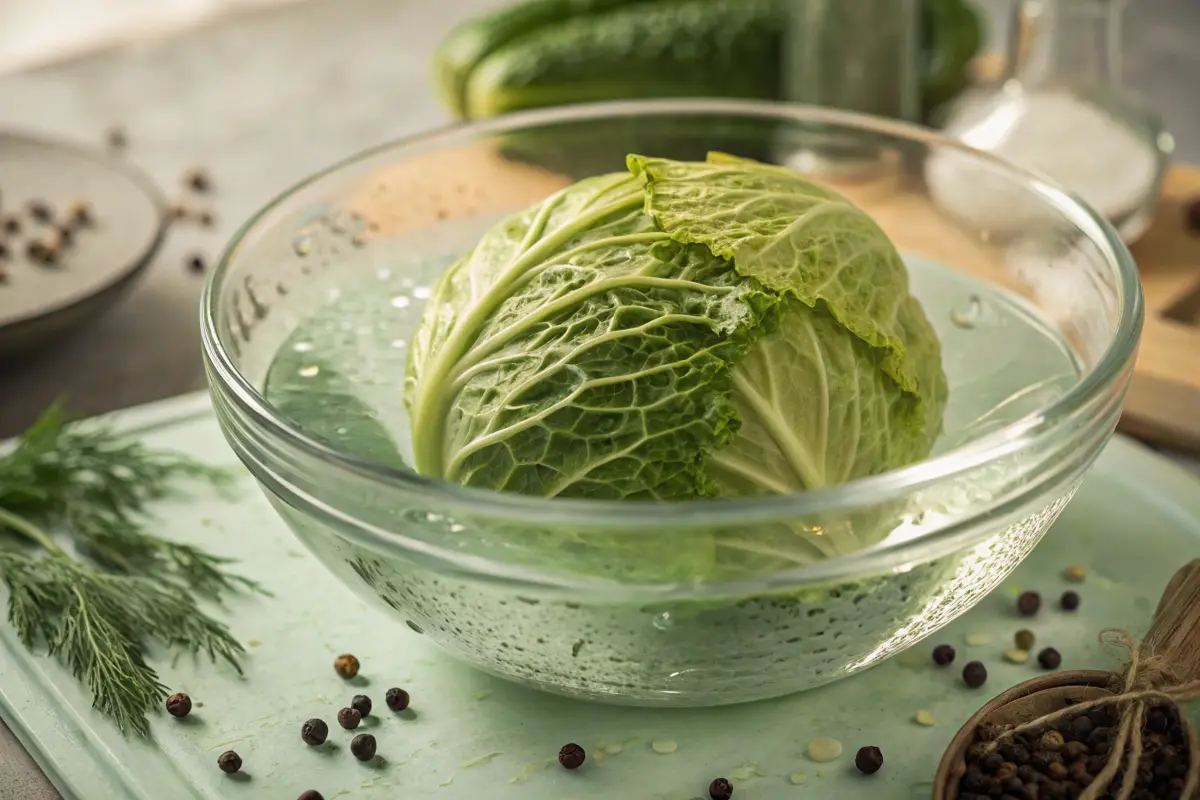Ever wondered why your grandma insisted on soaking cabbage before cooking it? It might seem like an extra step, but there’s more to it than meets the eye. In fact, the practice of soaking cabbage, a seemingly simple task, is rooted in centuries of culinary wisdom, practical needs, and even a bit of science. From getting rid of pesky critters to subtly enhancing flavor, soaking cabbage plays a crucial role in how your dish turns out. This article will delve into why you should soak cabbage before cooking, exploring its benefits and demystifying the reasons behind this common cooking practice. We’ll uncover not just why we soak cabbage before cooking, but also how best to do it.
Introduction to Soaking Cabbage
Why the Question Arises: The Mystery of Soaking Cabbage
So, you’ve got a head of cabbage and you’re ready to cook, right? Maybe you’re making a classic slaw or a hearty cabbage roll. But then you see that little note in a recipe, or perhaps your aunt chimes in, “Don’t forget to soak it!” This begs the question: why soak cabbage? It seems like just another step in an already busy kitchen, doesn’t it? Well, it’s more than just a random tradition. It’s a practice that’s born out of good, solid reasons, and by the end of this article, you’ll understand them all. So, why do you soak cabbage before cooking, you ask? Let’s find out.
Brief Overview of Common Cabbage Uses and Cooking Methods
Cabbage, a humble yet versatile vegetable, plays a starring role in various dishes around the globe. From the vibrant crunch of a coleslaw to the comforting warmth of cabbage soup, this leafy green is a culinary chameleon. You’ll find it stir-fried in Asian cuisine, braised in European stews, and even fermented into sauerkraut. Now, regardless of your cooking method – whether it’s boiling, steaming, sautéing, or even eating it raw – the question of soaking it first often arises. That’s because cabbage preparation isn’t always just about the cooking process.
Initial Thoughts: Common Beliefs About Soaking Cabbage
Before we delve into the nitty-gritty, it’s worth acknowledging the common beliefs surrounding soaking cabbage. Some people swear it gets rid of bitterness, while others believe it simply removes dirt. And yet, still others think that it’s all just an old wives’ tale! Well, some of these ideas are rooted in some truth, while others are a little off the mark. These varied viewpoints are part of why understanding the benefits of soaking cabbage is important. We need to separate fact from fiction, understand why you would soak cabbage before cooking, and make informed decisions in the kitchen.
Thesis Statement: Previewing the Benefits and Purpose of Soaking Cabbage
The practice of soaking cabbage before cooking isn’t just a matter of preference; it’s a smart move that addresses several critical factors. It helps with pest control, optimizes the cabbage’s texture, and, sometimes, enhances its flavor. Indeed, by soaking cabbage, you’re not only removing potential pests and dirt, but you’re also preparing it for the best possible culinary experience. From the historical roots of the method to the science behind it, this article will give you a comprehensive understanding of why you should soak cabbage, and ultimately help you up your cooking game.
The Historical and Cultural Context of Soaking Cabbage
Ancient Practices: How Soaking Originated in Traditional Cooking
The practice of soaking cabbage isn’t some modern fad; it’s a culinary technique that stretches back centuries. In ancient times, before modern farming practices and pesticides, cabbages, like other vegetables, were often susceptible to various pests and contaminants. Soaking was a simple yet effective way to ensure that these leafy greens were safe to eat. Indeed, historical records and traditional cooking methods often suggest that soaking was an essential part of cabbage preparation. Moreover, it wasn’t just about cleanliness; it was about ensuring the overall quality and safety of the food. Therefore, we see the origins of why you soak cabbage before cooking deeply rooted in necessity.
Regional Variations: Soaking Cabbage Across Different Cultures
Interestingly, the way cabbage is soaked, and even the reason why, can vary across different cultures. In some parts of Europe, soaking cabbage in saltwater is a traditional method to draw out insects and any lingering soil. Conversely, in other regions, a quick rinse may be favored. Additionally, different cultures might emphasize the softening effect that soaking has on the texture. Consequently, the cultural practices related to soaking illustrate that why we soak cabbage before cooking can sometimes be region-specific, reflecting unique local conditions and culinary preferences.
Evolution of Cooking Techniques: From Basic to Modern Soaking Methods
Over time, while the fundamental reason for soaking cabbage remained consistent – to clean and prep the vegetable – the methods have certainly evolved. From simple soaking in water to using salt or vinegar solutions, cooks have experimented to refine the process. Moreover, as access to cleaner water and better agricultural practices improved, some may have questioned the need for soaking. Nevertheless, the basic principle remains – soaking cabbage often makes for a better eating experience, regardless of the technological advancements in food preparation.
The Role of Soaking in Preserving Cabbage
Although we might not think about it, soaking can even play a role in the preservation of cabbage. For instance, before pickling or fermenting cabbage, a soaking and cleaning process is almost always necessary. It helps remove any undesirable elements that could affect the final product. Soaking contributes to the overall quality and helps extend the shelf life when preserving. Therefore, if you want to make sauerkraut, you definitely need to learn why you should soak cabbage before cooking.
Primary Reasons for Soaking Cabbage Before Cooking: Pest Control
The Hidden Inhabitants: Identifying Common Cabbage Pests and Insects
One of the main reasons why you should soak cabbage before cooking is simple: cabbage often harbors hidden inhabitants. These aren’t always visible to the naked eye. Small insects, such as aphids, cabbage worms, and thrips, can find their way into the tightly packed leaves. They often lay eggs there, as well. These tiny creatures can be quite difficult to remove just by rinsing, making a proper soak essential for thorough cabbage cleaning.
Why Rinsing Alone is Often Not Enough: The Necessity of a Proper Soak
While a quick rinse under the tap might seem like enough, it simply won’t cut it when it comes to removing pests from cabbage. The tightly packed leaves provide a secure hiding place for insects, and the force of water often isn’t sufficient to dislodge them. Therefore, soaking the cabbage in a basin of water is far more effective at flushing out these unwanted guests. Indeed, soaking allows the water to penetrate deep within the layers, ensuring that you’re not unknowingly adding extra protein to your meal.
Effective Soaking Methods to Remove Bugs: Saltwater Solutions and Vinegar

To tackle stubborn pests, adding salt or vinegar to the soaking water can be incredibly effective. A saltwater solution helps draw out the insects due to osmosis. Additionally, a vinegar solution can act as a natural repellent. Therefore, a proper soak with either salt or vinegar helps dislodge these critters more effectively than plain water. Moreover, these solutions are safe and food-grade, making them a smart choice for preparing cabbage.
Visual Evidence: Identifying signs of pests and how soaking helps
You might think your cabbage is clean, but take a closer look. Sometimes, tiny holes, small trails, or even the pests themselves can be visible. Seeing these signs is, indeed, an indicator that soaking is needed. Further, noticing the bugs in the soaking water after a soak is a visual confirmation that the method is working. Additionally, it should help underscore the importance of why we soak cabbage before cooking.
Debunking Myths: Addressing common misconceptions about soaking for pest control
Some people believe that soaking cabbage reduces its nutritional value. However, this simply isn’t the case, so long as you use a reasonable amount of time soaking the vegetable. The real benefit of soaking is ensuring that you get a clean and safe product free of pests. After all, no one wants a side of bugs with their dinner. It’s also important to note that soaking shouldn’t be confused with over-soaking, which could lead to a loss of crispness. As long as soaking is done properly, you’re not sacrificing nutrition in the name of pest control.
The Impact of Soaking on Cabbage Flavor and Texture
Soaking’s Effect on the Cabbage’s Cell Structure
Beyond removing pests, soaking cabbage can actually have a notable impact on its texture. When you submerge cabbage in water, a process called osmosis occurs. This process allows water to enter the cells of the cabbage, which in turn, makes them more turgid (or swollen). Consequently, the leaves become firmer and crispier. Therefore, this initial soak makes the cabbage more pleasant to eat, whether you’re planning on having it raw or cooked. It’s just one more reason why you soak cabbage before cooking.
Does Soaking Change the Cabbage’s Flavor Profile?
While soaking primarily affects the texture, it can also subtly influence the cabbage’s flavor profile. Some people find that soaking helps reduce the inherent bitterness often found in cabbage. Indeed, this slight bitterness is sometimes attributed to certain compounds that might be slightly drawn out through soaking. Additionally, while the change might not be dramatic, soaking often leads to a more palatable experience. Therefore, if you have had issues with the flavor of cabbage in the past, soaking might be the key to a better meal.
Enhancing Crispness and Reducing Bitterness Through Soaking
As mentioned earlier, the process of soaking can enhance the crispness of cabbage. This is incredibly helpful when making salads or slaws. Additionally, by drawing out some of the bitter compounds, soaking creates a more balanced flavor. Moreover, a simple soaking process can often make a huge difference in the end product. As such, learning the optimal way to soak cabbage can give you better control over both its texture and its taste.
Soaking and the Science of Osmosis: How it Affects the Cabbage
Understanding the science behind why soaking works can help to emphasize its importance. Osmosis, the movement of water across a semi-permeable membrane, plays a key role here. As the water moves into the cabbage cells, the leaves become more rigid and crisp, which will make them better to eat. Indeed, this process isn’t just about making the cabbage clean, but also about making it better. Furthermore, it’s this basic science that makes soaking such an effective way to prepare cabbage.
Different Soaking Lengths and Their Impact on Texture
The duration of the soaking time also impacts the final texture of the cabbage. For instance, a short soak, maybe 15 to 20 minutes, is often enough to remove pests and achieve slight crispness. However, over-soaking can lead to a loss of texture. If you soak it for too long, the cabbage may become waterlogged and limp. Therefore, finding the ideal soaking time is important for getting the desired consistency, which again, is why it’s useful to understand why you soak cabbage before cooking.
Soaking Cabbage: Breaking Down the Practical Methods
Step-by-Step Guide to Effective Cabbage Soaking
So, now that you know why you should soak cabbage before cooking, how do you actually do it? It’s pretty easy. First, remove any outer damaged or wilted leaves. Then, rinse the entire head under cool water. After that, fill a large bowl or sink with cool water and fully submerge the cabbage. You can also cut the cabbage in half or quarters if desired. The key here is to ensure that the leaves are entirely covered by the water.
Choosing the Right Type of Water: Tap Water vs. Filtered
While tap water is usually fine for soaking cabbage, some people prefer to use filtered water. Filtered water might be better for those who are sensitive to the taste of chlorine. Also, if your tap water has a particular taste, it might affect the flavor of the cabbage. However, the use of either tap or filtered water will often depend on the cook’s preferences and access to filtered water. So, it usually isn’t a big deal which type of water you use to soak cabbage.
The Correct Water Temperature for Soaking Cabbage
The ideal water temperature for soaking cabbage is cool to cold. Warm water could cause the cabbage to wilt, making it lose its crispness. Therefore, sticking with cold water is the best way to ensure that your cabbage keeps a good texture and form. As such, whenever you soak cabbage before cooking, stick to using cold water.
How long to soak cabbage: optimal time for best results
The optimal soaking time depends on a couple of things. A short soak of about 15-20 minutes should be enough to remove pests and freshen up your cabbage. However, you can soak it for up to 30 minutes for a more thorough clean. Just keep an eye on the cabbage and make sure that it does not become waterlogged. Soaking for too long can make it soft.
Adding Salt or Vinegar to the Soaking Water
As previously discussed, adding salt or vinegar to the soaking water has its benefits. About one to two tablespoons of salt or vinegar per quart of water is usually sufficient. These additions will help draw out insects and any remaining dirt. Moreover, they are also safe for consumption, making it a good choice when prepping your cabbage. However, if using salt, remember to rinse thoroughly after soaking.
Post-Soaking: Rinsing and Drying Methods
After soaking, it’s essential to rinse the cabbage thoroughly under clean, running water. This step will remove any remaining salt, vinegar, and dislodged pests. After rinsing, pat the cabbage dry with a clean kitchen towel or let it air dry. Indeed, this part of the process is essential for ensuring you have thoroughly prepped cabbage for your chosen recipe.
Addressing Common Concerns about Soaking Cabbage
Nutrient Loss: Does Soaking Cabbage Reduce its Nutritional Value?
One common worry people have is whether soaking cabbage causes it to lose its nutrients. While it’s true that some water-soluble vitamins might leach out slightly during soaking, the loss is usually minimal. Indeed, most of the nutrients in cabbage are held within its cellular structure and are not readily released into the water during a short soaking period. Therefore, the benefits of removing pests and improving texture greatly outweigh any minor potential loss in nutrients. In short, soaking cabbage is still a very good idea.
Over-Soaking: Potential Pitfalls and How to Avoid Them
While soaking cabbage is beneficial, over-soaking can be detrimental. Leaving cabbage submerged in water for extended periods can make it waterlogged. It can also cause the leaves to become limp and less crisp, as mentioned before. Moreover, the texture of the cabbage will not be what you would ideally want. Therefore, it’s important to stick to recommended soaking times to avoid these negative impacts. Keeping your soaking time to 30 minutes or less will usually be enough to get the desired results.
Soaking and Fermentation: When Soaking Becomes Something Else
It’s worth noting that the concept of soaking cabbage is quite different when it comes to fermentation. While some methods for fermenting cabbage (like sauerkraut or kimchi) may start with a type of brining, it’s not the same as the shorter soak we’ve been discussing. The process of fermentation is actually all about transforming the cabbage, so it’s a whole different ball game. Indeed, in these cases, the cabbage is submerged for longer periods, often in salty water, to encourage the development of beneficial bacteria and create a whole new flavor profile. So, keep in mind, soaking for cleaning is not the same thing as soaking for fermenting.
Alternatives to Soaking and When They Might Be Suitable
While soaking is a good practice, there are situations where a simple rinse might suffice. If, for example, you’re dealing with cabbage that you’re confident is clean and pest-free, you might opt for a quick wash. Also, if you’re short on time or only using small amounts of cabbage, a thorough rinse might be more practical. However, for most situations, and particularly if you’re not sure, soaking cabbage is the best and safest option. Soaking just provides a better overall experience.
The Different ways to use Soaked Cabbage
Prepping Soaked Cabbage for Different Cooking Methods
Once you’ve soaked and rinsed your cabbage, you have a blank canvas for a variety of dishes. The way you prep the cabbage next might vary depending on how you intend to cook it. For instance, if you’re planning to stir-fry or sauté it, you can slice or chop it as needed. Alternatively, for boiling or steaming, you might leave the leaves in larger pieces or wedges. Therefore, the next step will usually depend on how it will ultimately be used.

Soaking cabbage for raw recipes: salads and slaw
Soaking cabbage is particularly beneficial when using it raw in salads or slaws. It gives the cabbage a pleasant crispness, which makes the final dish much more enjoyable. It can also help with the flavor if you are sensitive to bitterness. Moreover, after soaking, the cabbage is clean and ready to be chopped or shredded as desired. As such, soaking cabbage before preparing a slaw or salad is a good idea.
Using Soaked Cabbage in Dishes: Stir-Fries and Casseroles
Whether you are making stir-fries or casseroles, properly soaked cabbage can enhance the final flavor and texture. It helps ensure that there is no dirt or pests present. Additionally, soaking the cabbage ahead of time makes it a breeze to add it to the dish during the cooking process. So, if you ever wondered why you soak cabbage before cooking, remember that it benefits a variety of dishes!
Soaked Cabbage and Fermentation: Prepping for Sauerkraut
If you’re planning on making sauerkraut, knowing how to properly prepare cabbage is super important. Soaking, rinsing and cleaning the cabbage is usually a very good first step. It can also be good to cut the cabbage, too. It helps the fermentation process start off in the right way. So, remember that soaking cabbage is also a good start for making sauerkraut.
Showcasing Recipes that Highlight the Benefits of Soaking
There are countless recipes that showcase the benefits of using soaked cabbage. Whether it’s a light and crunchy coleslaw, a hearty cabbage roll, or a flavorful stir-fry, the practice of soaking ensures a cleaner, crisper, and ultimately more enjoyable meal. Exploring a variety of recipes will allow you to see how soaking cabbage truly makes a difference. As such, remember to include this step anytime you cook with cabbage.
Conclusion: Reaffirming the Benefits of Soaking Cabbage Before Cooking
Summarizing the Key Reasons to Soak Cabbage
Throughout this article, we’ve explored various reasons why you should soak cabbage before cooking. First and foremost, it’s about ensuring thorough cleanliness and pest removal, which is paramount for safe consumption. In addition to this, soaking can also enhance the texture of cabbage, making it crisper and more enjoyable to eat. Furthermore, it can subtly influence the flavor, reducing bitterness and creating a more palatable experience. Indeed, these reasons combined make soaking a very useful step in cabbage preparation.
Final Thoughts on the Importance of Proper Cabbage Preparation
Proper cabbage preparation extends beyond simply cooking it. Indeed, taking the time to soak your cabbage correctly can make a significant difference in the quality of your meal. It’s not just about getting rid of bugs; it’s about optimizing the flavor, texture, and overall safety of this wonderful vegetable. Furthermore, knowing why we soak cabbage before cooking empowers you to make informed choices in the kitchen.
Encouraging Readers to Experiment with Soaking Techniques
Now that you understand why you soak cabbage before cooking, don’t be afraid to experiment with different soaking techniques. Try different soaking times, or explore using saltwater or vinegar to see what works best for your needs. Moreover, exploring a variety of different methods can give you more control over the end result. The best part is, you can adjust the soaking process according to the recipe and your personal tastes. As such, the next time you grab a head of cabbage, remember this advice.
Frequently Asked Questions
Do I Really Need To Soak Cabbage Before Cooking?
While it’s not absolutely mandatory, soaking cabbage is highly recommended. It is the most effective way to remove hidden pests and dirt, which can otherwise go unnoticed. In addition to this, it can also improve the overall texture and flavor of the vegetable. Therefore, though you could skip this step, it’s almost always better to take the time to soak. So, why do you soak cabbage before cooking? For better results!
How long does cabbage need to soak?
The ideal soaking time is usually around 15 to 30 minutes. This should be enough time to remove pests, dirt, and improve the cabbage’s texture, without causing it to become too waterlogged. However, if you are short on time, a quick 15-minute soak is usually enough.
What is the best way to soak cabbage?
The best way to soak cabbage is to submerge it fully in a bowl or sink filled with cool water. You can also add one or two tablespoons of salt or vinegar per quart of water. These additions can help to dislodge any insects or dirt that may be hiding in the leaves.
Can I soak cabbage in warm water?
It is generally not recommended to soak cabbage in warm water. Warm water can cause the leaves to wilt and lose their crispness. Therefore, sticking to cool or cold water is generally the best way to maintain the texture of your cabbage.

